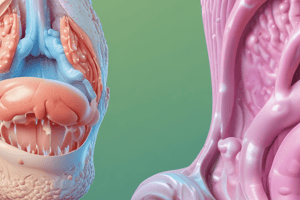Podcast
Questions and Answers
What is urinary incontinence and how does it impact individuals' lives?
What is urinary incontinence and how does it impact individuals' lives?
Urinary incontinence is the involuntary loss of urine that impacts physical, psychological, and social well-being, resulting in a significant reduction in quality of life.
Describe the process of bladder filling and the typical volume that triggers the urge to urinate.
Describe the process of bladder filling and the typical volume that triggers the urge to urinate.
The bladder fills normally until it contains about 250 ml of urine, which typically triggers the urge to urinate.
What are the primary types of urinary incontinence mentioned in the text?
What are the primary types of urinary incontinence mentioned in the text?
The primary types include stress urinary incontinence (SUI), urge incontinence, mixed incontinence, overflow incontinence, functional incontinence, and reflex incontinence.
What triggers stress urinary incontinence (SUI) and what anatomical factors are involved?
What triggers stress urinary incontinence (SUI) and what anatomical factors are involved?
How is urge incontinence defined and what might cause it?
How is urge incontinence defined and what might cause it?
What role does the detrusor muscle play in urinary bladder function?
What role does the detrusor muscle play in urinary bladder function?
Discuss the significance of age in the prevalence of urinary incontinence.
Discuss the significance of age in the prevalence of urinary incontinence.
What impact does urinary incontinence have on an individual's quality of life?
What impact does urinary incontinence have on an individual's quality of life?
What are the primary symptoms associated with urinary incontinence?
What are the primary symptoms associated with urinary incontinence?
Define mixed incontinence and its contributing factors.
Define mixed incontinence and its contributing factors.
What distinguishes reflex incontinence from other types?
What distinguishes reflex incontinence from other types?
In functional incontinence, where does the issue primarily lie?
In functional incontinence, where does the issue primarily lie?
What causes overflow incontinence?
What causes overflow incontinence?
What are extraurethral sources of urine and their potential causes?
What are extraurethral sources of urine and their potential causes?
Identify two major risk factors that increase the likelihood of urinary incontinence.
Identify two major risk factors that increase the likelihood of urinary incontinence.
How might obesity influence urinary incontinence?
How might obesity influence urinary incontinence?
What effect does extra weight have on the bladder and surrounding muscles?
What effect does extra weight have on the bladder and surrounding muscles?
How does smoking affect the risk of urinary incontinence?
How does smoking affect the risk of urinary incontinence?
What type of family history can increase the risk of urinary incontinence?
What type of family history can increase the risk of urinary incontinence?
What is the purpose of maintaining a voiding diary in the evaluation of urinary incontinence?
What is the purpose of maintaining a voiding diary in the evaluation of urinary incontinence?
What is measured by the postvoid residual urine volume test?
What is measured by the postvoid residual urine volume test?
What does a positive deflection in the Q-tip test indicate?
What does a positive deflection in the Q-tip test indicate?
Which medical conditions might exacerbate urinary incontinence?
Which medical conditions might exacerbate urinary incontinence?
What role do diuretics play in urinary incontinence?
What role do diuretics play in urinary incontinence?
What is indicated by a positive deflection of the Q-tip during the Q-tip test?
What is indicated by a positive deflection of the Q-tip during the Q-tip test?
What are the two main types of urodynamic tests mentioned for urinary incontinence assessment?
What are the two main types of urodynamic tests mentioned for urinary incontinence assessment?
What abnormality might a cystoscopy help identify in patients?
What abnormality might a cystoscopy help identify in patients?
What conservative therapies are mentioned for treating stress urinary incontinence (SUI)?
What conservative therapies are mentioned for treating stress urinary incontinence (SUI)?
What factors may exacerbate stress urinary incontinence?
What factors may exacerbate stress urinary incontinence?
What drug is commonly prescribed for detrusor overactivity (DO)?
What drug is commonly prescribed for detrusor overactivity (DO)?
How does electrical stimulation help in pelvic muscle rehabilitation?
How does electrical stimulation help in pelvic muscle rehabilitation?
What role do estrogens play in treating urinary issues in postmenopausal women?
What role do estrogens play in treating urinary issues in postmenopausal women?
What urinary symptoms does HRT not reduce in postmenopausal women?
What urinary symptoms does HRT not reduce in postmenopausal women?
What is the most common bulking agent used in SUI treatment?
What is the most common bulking agent used in SUI treatment?
What is the primary goal of the retropubic urethropexy?
What is the primary goal of the retropubic urethropexy?
What is the typical success rate of the Burch procedure for SUI?
What is the typical success rate of the Burch procedure for SUI?
What do suburethral sling procedures achieve during increased intra-abdominal pressure?
What do suburethral sling procedures achieve during increased intra-abdominal pressure?
What are some common complications associated with suburethral sling procedures?
What are some common complications associated with suburethral sling procedures?
For whom are injection of bulking agents generally indicated?
For whom are injection of bulking agents generally indicated?
What is a key characteristic of urinary incontinence related to intrinsic urethral sphincteric deficiency?
What is a key characteristic of urinary incontinence related to intrinsic urethral sphincteric deficiency?
Flashcards are hidden until you start studying
Study Notes
Urinary Incontinence
- Urinary incontinence (UI) is the involuntary loss of urine that is objectively demonstrable and causes a social or hygienic problem.
- UI affects more than 13 million people in the US.
- Prevalence of UI in women:
- 5% between 15-44 years of age
- 10% between 45-64 years of age
- 20% older than 65 years of age
- UI can significantly impact an individual’s physical, psychological, and social well-being.
The Lower Urinary Tract
- The lower urinary tract consists of the bladder and urethra.
- Bladder:
- A hollow muscular organ lined with transitional epithelium for urine storage.
- Contains three layers of smooth muscle that make up the detrusor muscle.
- The detrusor muscle relaxes for urine storage and contracts to completely evacuate urine when appropriate.
- The bladder base contains the trigone.
- The vesical neck and urethra are about 3-4 cm long.
Normal Bladder Filling
- The bladder typically fills with 250 mL of urine before the urge to urinate arises.
Types of Urinary Incontinence
- Stress Urinary Incontinence (SUI)
- Loss of urine with increased abdominal pressure (coughing, straining).
- Caused by loss of anatomical support of the urethrovesical junction or urethra.
- Often develops following pelvic floor muscle and nerve damage during childbirth.
- Urge Incontinence (Overactive Bladder)
- Urine loss with a strong urge to void.
- Can be caused by conditions such as infection or neurological disorders.
- Frequently accompanied by urinary frequency, urgency, and nocturia.
- Mixed Incontinence
- Combines both stress and urge incontinence symptoms.
- Overflow Incontinence
- Occurs due to underactivity of the detrusor muscle.
- Results in bladder retention and dribbling of urine.
- Functional Incontinence
- Inability to get to the toilet in time due to physical or cognitive limitations.
- Often associated with conditions like arthritis, dementia, or depression.
- Reflex Incontinence
- Unexpected urine loss caused by bladder detrusor muscle spasm.
- Individuals do not feel an urge to urinate.
- Caused by neurological factors that influence messaging between the brain and bladder.
- Can be spinal or supraspinal.
- Often associated with conditions like multiple sclerosis, dementia, stroke, Alzheimer's disease, and Parkinson's disease.
- Extraurethral Sources of Urine
- Leakage of urine not through the urethra.
- Can be caused by genitourinary fistulas.
- May be congenital or occur following pelvic surgery, obstetrical complications, infection, or radiation.
Evaluation
- A thorough medical history should include:
- Urinary symptoms: frequency, nocturia, urgency, precipitating events, and frequency of incontinence episodes.
- Previous urologic surgery.
- Obstetrical history: parity, birth weights, and mode of delivery.
- CNS or spinal cord disorders.
- Medication use: diuretics, antihypertensives, caffeine, alcohol, anticholinergics, decongestants, nicotine, and psychotropics.
- Presence of other medical disorders (hypertension, hematuria).
- Physical examination may detect:
- Exacerbating conditions (chronic obstructive pulmonary disease, obesity, intra-abdominal mass).
- Hypermobility of the urethra.
- Pelvic organ prolapse (POP).
- Neurologic disorder.
Diagnostic Tests
- Midstream urine specimen
- Collected for urinalysis or culture and sensitivity testing.
- Infection can worsen urinary incontinence.
- Postvoid residual urine volume
- Measured using ultrasound or catheterization after voiding.
- Normally less than 50 mL.
- Q-tip test
- Indirect measure of urethral axis.
- Q-tip inserted into the urethra with the patient in lithotomy position.
- If the Q-tip moves more than 30 degrees from the horizontal with straining, urethral hypermobility is present.
- Urodynamic testing
- Includes cystometrogram and voiding studies.
- Measures bladder and abdominal pressure during bladder filling and emptying.
- Used for complex cases of urinary incontinence or when incontinence and urine retention co-exist.
- Cystoscopy
- Examination of the bladder and urethral mucosa for abnormalities like diverticula or neoplasms.
Risk Factors
- Gender: Women are more likely to experience stress incontinence, due to pregnancy, childbirth, menopause, and anatomical differences.
- Age: Older individuals may experience weakening of bladder and urethral muscles, resulting in reduced bladder capacity and increased urine loss.
- Being overweight: Excess weight increases pressure on the bladder and surrounding muscles, leading to weakness and increased urine leakage.
- Smoking: Tobacco can increase the risk of urinary incontinence.
- Family history: Individuals with a family history of urinary incontinence, especially urge incontinence, are at higher risk.
- Certain diseases: Neurological diseases or diabetes can increase the risk of incontinence.
Treatment
- Treatment depends on the underlying diagnosis.
- Treatment of Exacerbating Factors:
- Weight loss: To decrease abdominal pressure.
- Treatment of chronic cough: To improve coughing-related leakage.
- Management of constipation: To reduce pressure on the bladder.
- Pelvic Muscle Rehabilitation:
- Kegel exercises: To strengthen pelvic floor muscles.
- Vaginal cones: To improve muscle strength.
- Biofeedback: To improve pelvic floor muscle control.
- Electrical stimulation: To stimulate muscle contractions.
- Drug Therapy:
- Antispasmodic agents (Tolterodine): Effective in treating urge incontinence (overactive bladder).
- α-Adrenergic stimulating agents: May reduce stress incontinence by strengthening the urethral sphincter.
- Estrogens: May improve irritative bladder symptoms in postmenopausal women but lack significant effectiveness in reducing urine leakage.
- Surgery:
- Injection of bulking agents around the urethra: Minimally invasive procedure for SUI caused by intrinsic urethral sphincteric deficiency. Provides temporary improvement.
- Retropubic urethropexy (Burch procedure): Elevates the urethra and bladder neck by fixing the paraurethral tissues to the pubic bone. Effective for SUI with urethral hypermobility.
- Transvaginal needle procedures: Minimally invasive procedures to elevate the urethra and bladder neck.
- Suburethral sling procedures: Synthetic materials placed under the urethra to improve support and reduce leakage. Highly effective for SUI caused by intrinsic urethral sphincteric deficiency.
- Tension-free vaginal tape (TVT) procedure: A commonly used suburethral sling procedure.
Studying That Suits You
Use AI to generate personalized quizzes and flashcards to suit your learning preferences.




